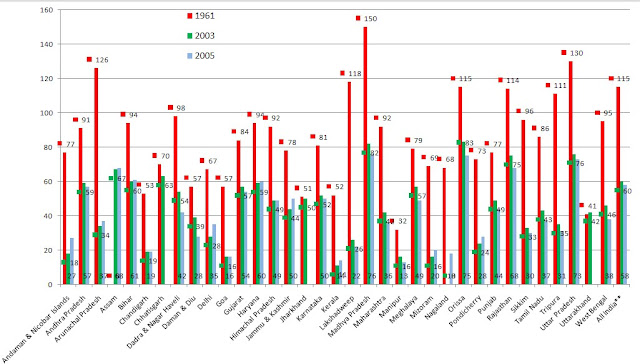Is it not a Eureka moment for India, when a chief minister (the ablest they say) says our children are malnourised only because of figure consciousness? How sweet! Imagine a child aged 2 or 4 looking at our zero figure, Kareena Kapoor and dreaming to be like her? Or the boys like Salman Khan? Or let us imagine that it is their mothers who are making these poor ones starve in order to attain the zero figure. If so, damn these mothers!
He also says that it is because of vegetarianism. But in this case how about Punjab?
There are more vegetarians in Punjab than in Gujarat and yet Punjab, along with Kerala and north east states like, Manipur, Mizoram and Sikkim are the states where there are less malnourished children.
It must be hard to swallow the truth since India has been up in the chart since years for having the most malnourished under-5 children. We are way up above the poorest African countries too!
The World Bank estimates that India is ranked 2nd in the world of the number of children suffering from malnutrition, after Bangladesh (in 1998), where 47% of the children exhibit a degree of malnutrition. The prevalence of underweight children in India is among the highest in the world, and is nearly double that of Sub-Saharan Africa with dire consequences for mobility, mortality, productivity and economic growth.[
Now let us look at the Infant Mortality Rates or the number of Infants dying under one year of age per 1000 births in the same year.
Even here, states like Gujarat which claims development paints a dismal picture. One can download the Family Statistics Report 2011 to get the complete picture.
Health is wealth. The nation's wealth lies in it's citizens and if good health cannot be provided to our furture generation then this nation will continue to lag behind in every other area of development.
The effect of undernutrition on young children (ages 0-8) can be devastating and enduring. It can impede behavioral and cognitive development, educability, and reproductive health, thereby undermining future work productivity. Since growth failure occurs almost exclusively during the intrauterine period and in the first two years of life, preventing stunting, anemia, or xerophthalmia, therefore calls for interventions, which focus on the very young.
Whether or not children are well-nourished during their first years of life can have a profound effect on their health status, as well as their ability to learn, communicate, think analytically, socialize effectively and adapt to new environments and people. Good nutrition is the first line of defense against numerous childhood diseases, which can leave their mark on a child for life. In the area of cognitive development, "when there isn't enough food, the body has to make a decision about how to invest the limited foodstuffs available. Survival comes first. Growth comes second. In this nutritional triage, the body seems obliged to rank learning last. Better to be stupid and alive than smart and dead" (Sagan and Druyan).
But then the paradox is that a section of the society is facing obesity too.
Hope Modi realizes that his state too ranks pretty high in the obesity list (7th in the country).
So who is beauty consious? Himself?
So who is beauty consious? Himself?
Source:
http://www.unicef.org/nutrition/index_statistics.html
http://apps.who.int/nutrition/landscape/report.aspx?iso=IND&rid=161&template=nutrition&goButton=Go
http://web.worldbank.org/WBSITE/EXTERNAL/TOPICS/EXTCY/EXTECD/0,,contentMDK:20207804~menuPK:528430~pagePK:148956~piPK:216618~theSitePK:344939,00.html
Human Development Report 2011
http://www.dnaindia.com/india/report_narendra-modis-beauty-pill-hard-to-swallow_1735020
http://www.who.int/healthinfo/EN_WHS2012_Full.pdf










